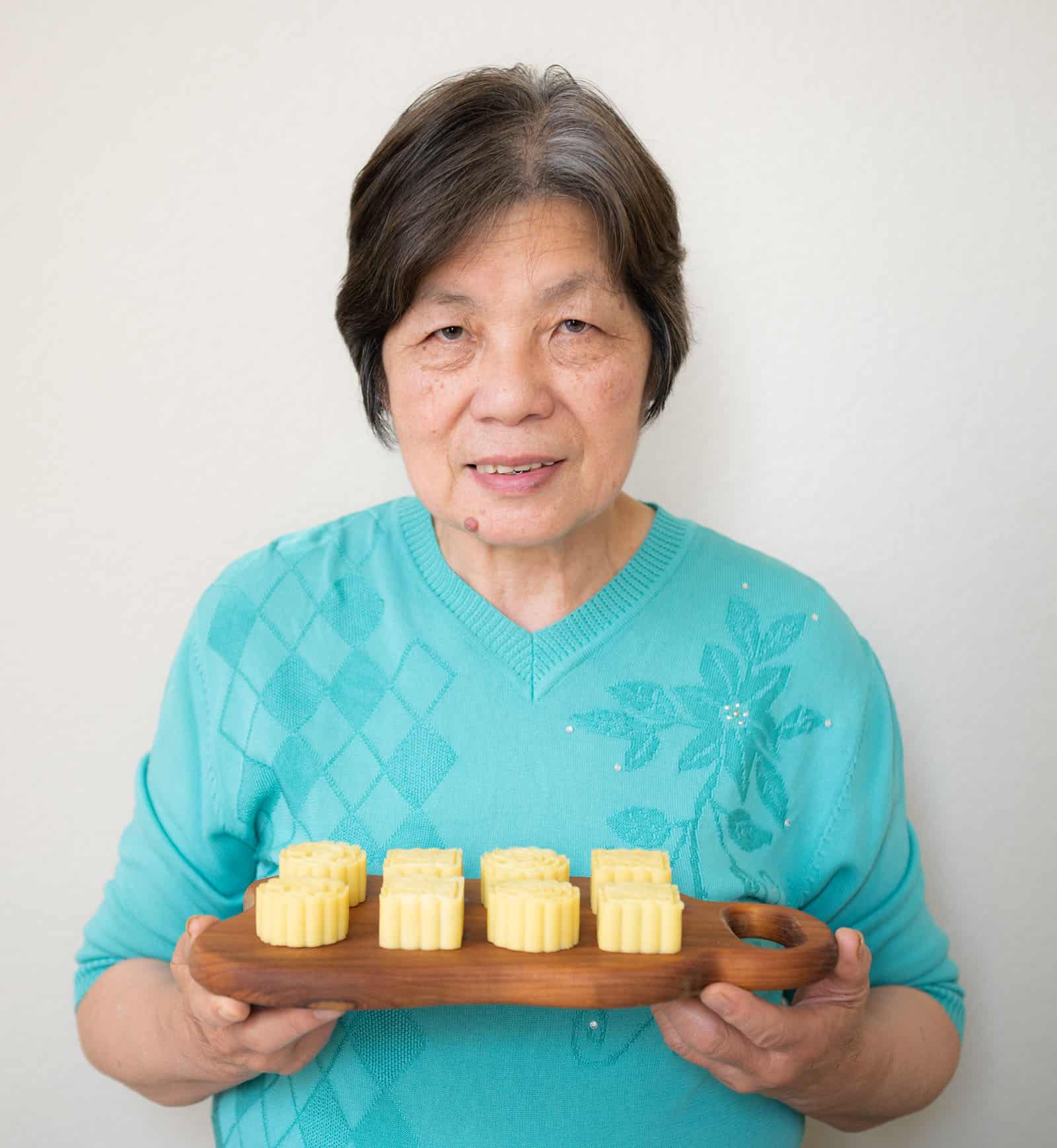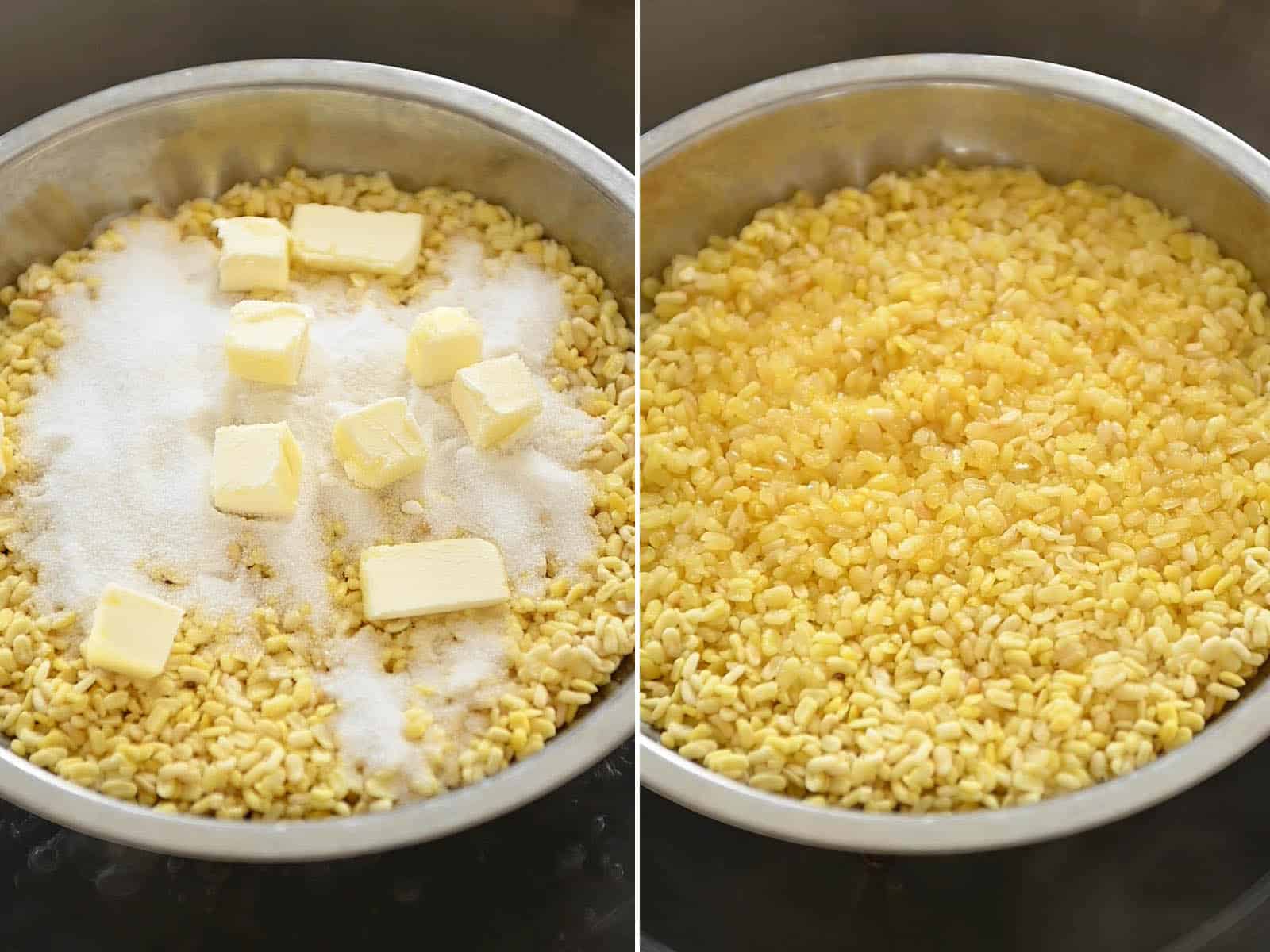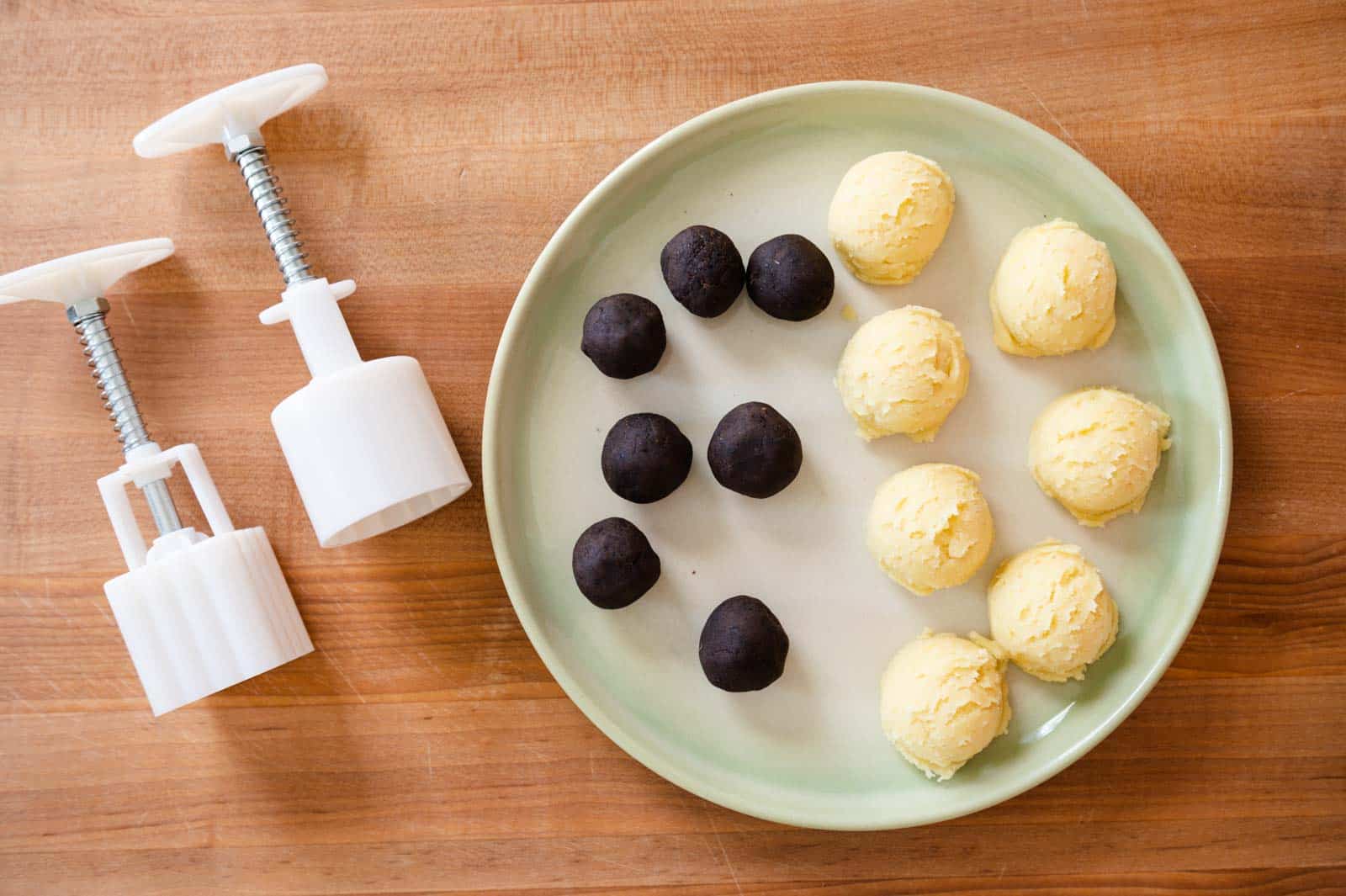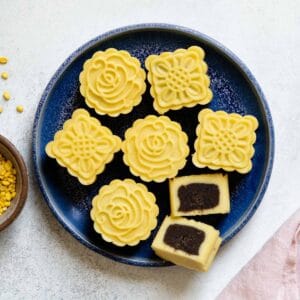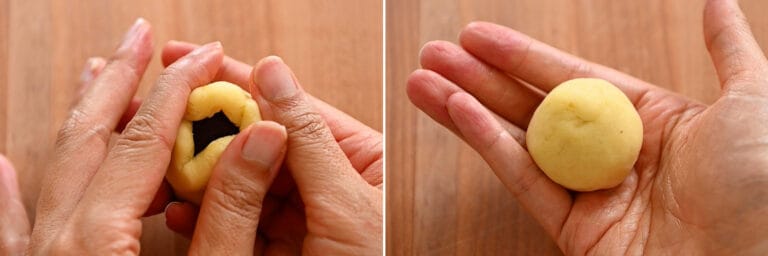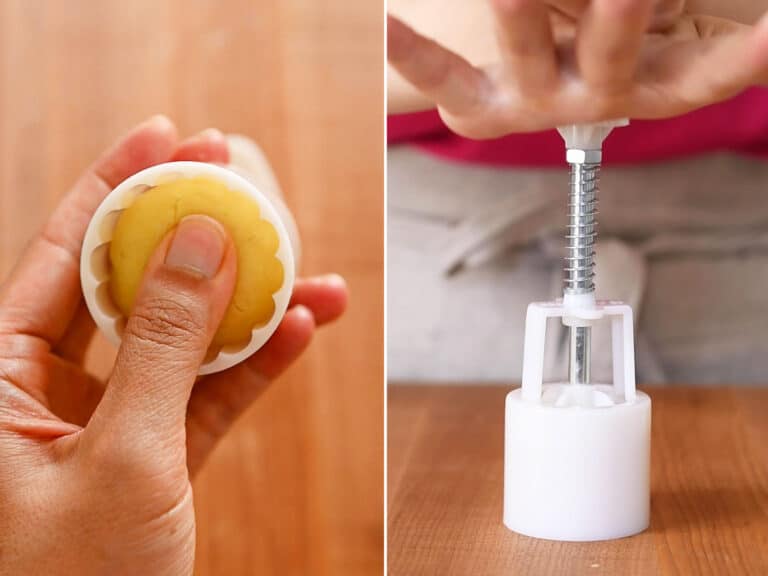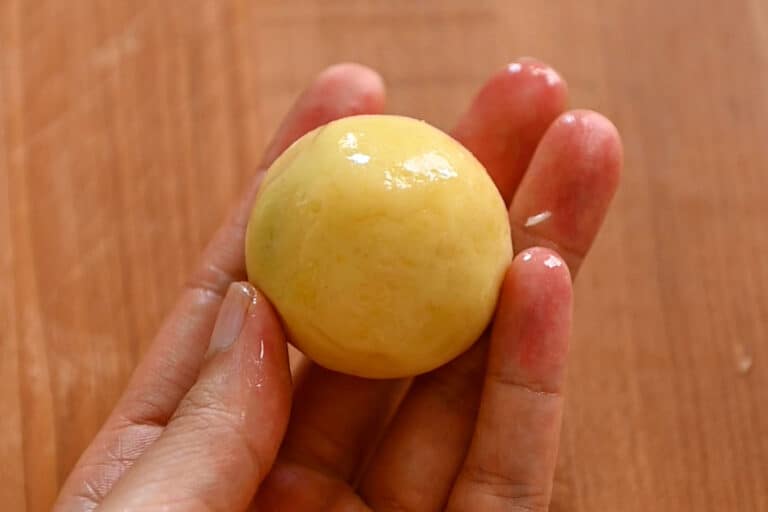Although the mung bean cakes look like mooncakes (particularly because they’re shaped with a mooncake press), they are not traditional mooncakes. Traditional southern Chinese mooncakes are baked pastries with a thin layer of dough on the outside, encasing a bean paste and one or two salted egg yolks. I still haven’t mustered the willpower to develop a traditional mooncake recipe from scratch because there are so many steps involved. Therefore, these mung bean cakes are going to be the closest thing to a mooncake that I’ll be making to celebrate the Mid-Autumn Festival (中秋節/中秋节) this year.
HOW TO MAKE MUNG BEAN CAKES
PREPARE BEANS
For this recipe, you’ll need split mung beans (also known as moong dal or mung dal in Hindi). Rinse the beans with 2 to 3 changes of water to wash away some of the yellow color. Transfer the beans to a bowl and fill the bowl with enough water so that the water line is about 2 inches above the beans. Soak the beans overnight.
STEAM BEANS
Add a steaming rack to a large wok. Fill the wok with water, until there’s about a 1/2-inch gap between the water level and the top of the steaming rack. Cover the wok and bring the water to boil. Drain the beans and spread them over a large plate or pan that you can use for steaming. Carefully place the plate or pan of beans over the steaming rack, cover the wok, and steam the beans on medium-high heat for 25 minutes. After 25 minutes of steaming, a lot of the water inside the wok will have evaporated. Fill a measuring cup with a spout (like a Pyrex) with about 3/4 cup of water. Carefully pour the water into the bottom of the wok. Sprinkle the sugar all over the beans. Then, spread out small cubes of butter over the sugar. Cover the wok, and steam for another 5 to 7 minutes. Turn off the heat. The butter and sugar should have melted already. Check to make sure the beans are done cooking by crushing a bean with your fingers. It should break down very easily.
SHAPE RED BEAN PASTE FILLING
The mung bean cake recipe that my aunt shared with Mama Lin used red bean paste as a filling. You can use my red bean paste recipe here to cook the bean paste or purchase red bean paste. If you’re buying the paste, make sure the paste is firm enough to roll into balls. If not, pan fry the paste to reduce the liquid, until the paste is firm. While the beans are steaming, shape the red bean paste into small balls. You’ll need 14 to 15 pieces of red bean paste, each weighing 15 grams, about 1 flat tablespoon of bean paste. I like using a small cookie scoop (affiliate link) for measuring this amount. You’ll likely have red bean paste leftover, which you can snack on or refrigerate/freeze for later use.
FINISH MAKING MUNG BEAN PASTE
Right after you finish steaming the beans, transfer the cooked beans mixture and the coconut oil into the bowl of a food processor. You may want to use an oven mitt or a tea towel to hold onto the hot plate or pan. Blend everything until smooth. Some recipes suggest straining the mung bean paste through a fine mesh strainer to make it smoother. I don’t find it necessary; I don’t mind chewing on a few beans here and there. Moreover, the mung bean paste cracks easily once it cools, so it’s better to move on to the next step quickly rather than strain the bean paste. However, if you decide to strain this paste, reheat it in a nonstick pan for a minute or two. Scoop out seven (7) 30-gram pieces of mung bean paste straight from the bowl of the food processor. Don’t even bother transferring the paste to a bowl, as this will cool it down. I like using a medium cookie scoop (affiliate link) to measure this amount. Because of the mung bean paste’s tendency to crack, shape and press 7 mung bean cakes at a time. Cover the rest of the mung bean paste with the lid of the food processor to keep it warm.
FORM MUNG BEAN BALLS
Take one piece of mung bean paste and roll it into a ball. Using your fingers, shape the paste into a shallow bowl, about 2 to 2 1/2 inches wide (see photo above). If you find it difficult to shape the paste into a bowl, just shape it into a flat disc, about 2 1/2 inches wide. Take a piece of the red bean paste and place it onto the center of the mung bean bowl/disc. Wrap the mung bean paste around the ball of red bean paste. I like to use the crook of my right hand to mold the mung bean layer around the red bean paste. Pinch the mung bean layer together so that the red bean paste is fully encased. Roll the ball of dough in your hands until the surface is smooth. Set the ball of dough aside. Continue wrapping the remaining 6 pieces of mung bean paste around the red bean paste balls.
SHAPE MUNG BEAN CAKES IN MOONCAKE PRESS
Take one of the large balls of dough and place it into the mooncake press. Use your fingers to gently press the dough into the mold so it doesn’t slip out when you flip the mooncake press over onto your work surface. Press down on the mooncake press with medium pressure and then release the cake. Transfer the mung bean cake to a plate. Continue shaping the remaining large balls of dough with the mooncake press.
FINISH SHAPING REMAINING PASTE TO MUNG BEAN CAKES
Uncover the remaining mung bean paste, divide into 30-gram pieces, wrap around the balls of red bean paste, and shape into cakes with the mooncake press.
TROUBLESHOOTING TIPS
Mung Bean Dough Keeps Cracking: It is very important that you shape the mung bean layer while it’s still very warm. Otherwise, the dough will crack. That’s why I recommend scooping the mung bean paste straight from the bowl of a food processor instead of transferring it to another container. However, if the dough is still cracking a lot, mix in 1 or 2 teaspoons of water or oil to moisten the mung bean dough. I should also note that if you reduce the amount of sugar for the mung bean paste, this will increase the likelihood of cracking. That’s because sugar provides moisture and liquifies as it dissolves. If you reduce the amount of sugar in the mung bean paste significantly, the paste will be less moist, thereby increasing the chances for cracking. Cake Getting Stuck to Mooncake Press: If the mung bean cake is stuck to the press as you release the cake, remove the cake completely. Then, use a toothpick to clean out the crevices of the mooncake stamp. Before you shape the next mung bean cake, rub a thin layer of oil over the large dough balls before inserting into the mooncake press. You can use any neutral-flavored oil like sunflower or vegetable oil. Using Square Mooncake Presses: The large dough balls might not fit easily into a square mold. Shape the large ball of dough into an oblong oval shape, like a thick log. Now, when you insert the dough into the mooncake press, the dough won’t scrape against the edges of the press.
EATING AND STORING MUNG BEAN CAKES
Enjoy the mung bean cakes right away or save for later. You can leave them out at room temperature for a few hours. Because the tops of the cake crust over easily, make sure to cover them up. If you’re not going to eat them in the next few hours, refrigerate them in a container. The cakes are also pleasant to eat when they’re chilled. Eat the mung bean cakes within 3 to 4 days as they can develop mold over time.
MAKING CAKES WITHOUT FILLING
Although my aunt’s recipe uses red bean filling, you can make the cakes with mung bean paste only! Just measure out 30-gram pieces of the mung bean paste and shape them with the mooncake press.

